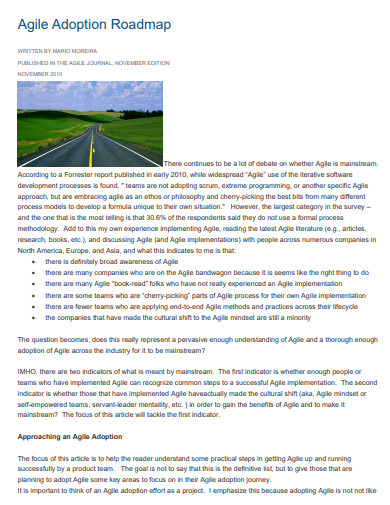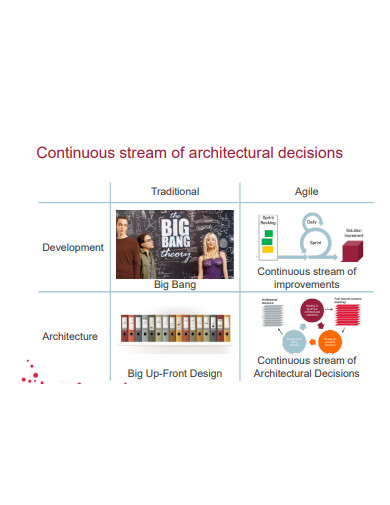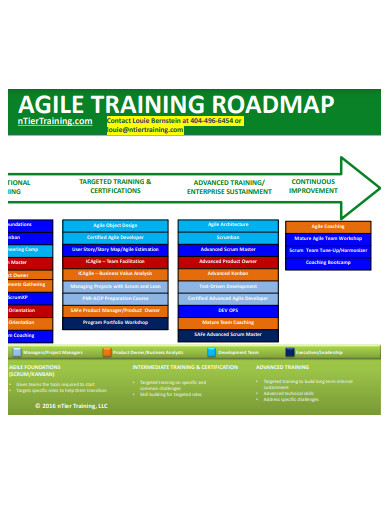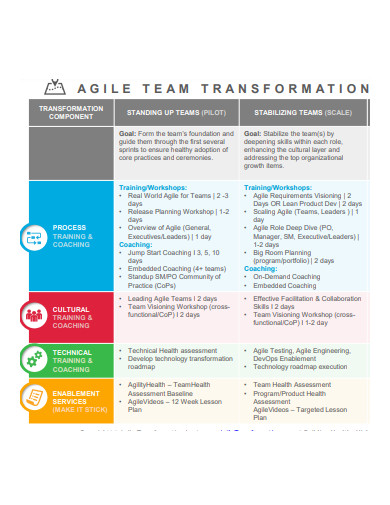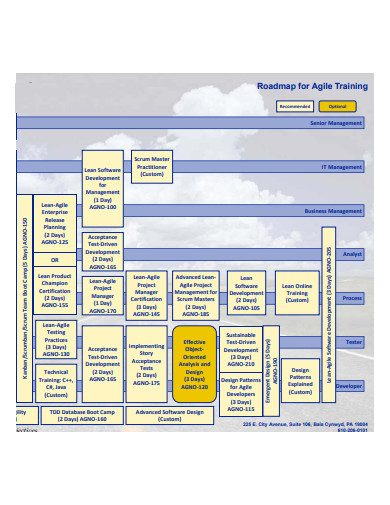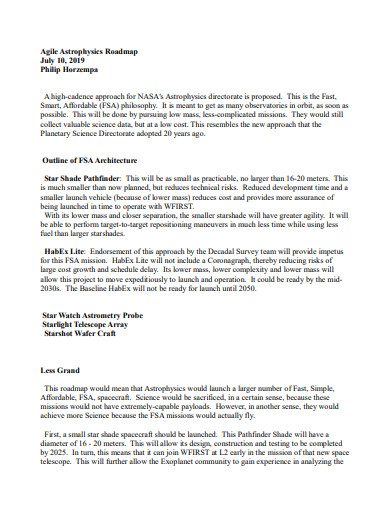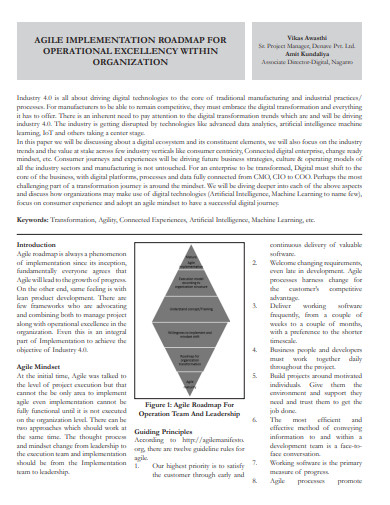Create a likeable product that gives clients exactly what they desire. This is what the best product managers strive towards. An agile approach to product management appeals to many product managers because it promises to create value faster. You can be more nimble by using an incremental approach to product development, modifying product plans and iterating frequently depending on user feedback and other data. However, moving quickly while ensuring that you are pursuing the proper tasks — activities that support a really agile product strategy — can be difficult. This is where an agile roadmap comes in handy.
10+ Agile Roadmap Samples
A dynamic plan of action for attaining your product goal is an agile roadmap. It announces planned product releases and explains how each epic and feature fits into your overall product strategy. You can use an agile roadmap to illustrate all of the cross-functional efforts involved in developing and marketing a product or improvement. An agile roadmap can represent high-level product goals and activities or a more near-term schedule of impending work, depending on the amount of detail you wish to convey. It’s worth noting that some agile teams believe their iterative way of operating is contradictory with the road mapping method.
1. Agile Project Roadmap
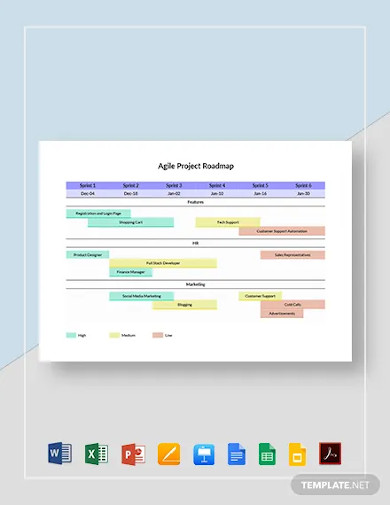
2. Agile Marketing Roadmap
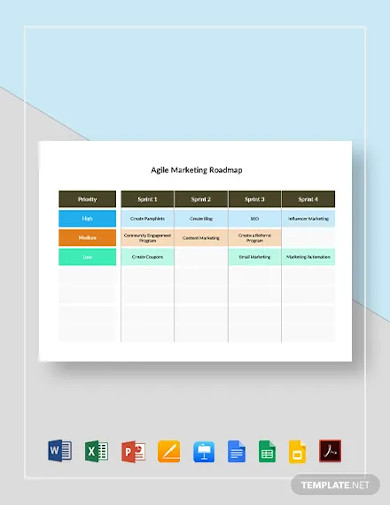
3. Agile Management Roadmap
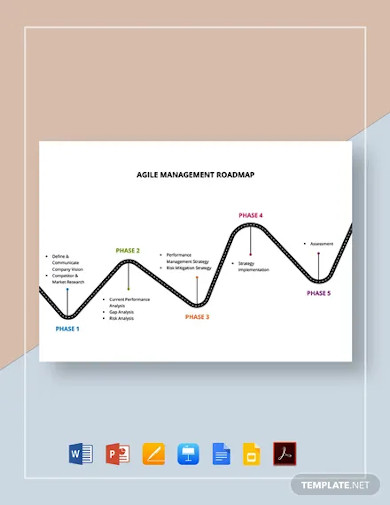
4. Agile Adoption Roadmap
5. Agile Architecture Roadmap
6. Agile Training Roadmap
7. Agile Transformation Roadmap
8. Agile Team Transformation Roadmap
9. Agile Training Roadmap
10. Agile Astrophysics Roadmap
11. Agile Implementation Roadmap
Building an Agile Roadmap
It includes initiatives, deliverables, features or user stories, and timelines, just like most other corporate roadmaps. Your method to outlining each piece, as well as your readiness to adjust when plans alter, are what make your roadmap agile. The following are seven steps to creating an agile roadmap:
Start with product strategy and goals
Fast-moving agile teams cannot evaluate if they are making substantial progress without a strategic approach. Goals establish what you want to achieve over a period of time, with clear criteria for measuring success, whereas strategy expresses the problem you’re solving for clients. You’ll probably set monthly or quarterly targets in an agile workplace.
Turn your goals into initiatives
Initiatives (also known as epics) are work themes that complement the product vision and enable you to reach your objectives. Features and user stories are divided down into ventures, which often span numerous releases. Before you specify new features to follow, make certain that the plan corresponds with your objectives when your agile team wishes to pivot based on the latest data or user input.
Gather cross-functional feedback
Getting feedback from other teams is crucial for creating an accurate, thorough, and practical agile roadmap. Every cross-functional team that collaborates to developing and executing a Complete Product Experience – engineering, marketing, design, sales, and customer service, to highlight a few — should provide feedback. Consider adopting purpose-built tools to develop your agile roadmap if you need to interact with organizations that are conventionally non-agile (such as finance offices or the legal department) and require longer timescales. This can make coordinating and tracking multiple work streams and timeframes easier.
Define product features and tie to strategic initiatives
Now is the time to divide your broad work themes into components or user stories. Your features reflect the new functionality that you will provide to clients on a regular basis. The features are then broken down into technical aspects and organized into sprints by development teams. Choose which features to highlight based on your product concept, goals, and efforts. You can provide work and modify efficiently when all of your features are linked to the overarching product plan.
Plan your product releases
Structure the features in your agile roadmap into milestones to provide customers with significant value over time. It’s entirely up to you whether you release daily, weekly, monthly, or quarterly. Merely keep in mind that a release varies from a sprint or iteration in that it focuses on delivering a new user experience (rather than just providing code) and includes all cross-functional work required to accomplish so. Releases are still critical in an agile context because they inform teammates and customers about what to anticipate and when.
Capture and integrate customer feedback
Customer input should be collected on a regular basis as part of your agile roadmap. Some teams get ideas using methods such as interview sessions, usability testing, and usage data. You may identify when to make changes by matching each feature to the marketing plan (versus when to stick to the plan).
Measure results regularly
Moving swiftly makes it even more important to keep track of your progress toward your objectives. You might assess outcomes and update your agile product roadmap weekly, monthly, or quarterly, relying on your release cadence. Examine how each new release or feature affects key KPIs like client acquisition, retention, conversion rate, and churn. Evaluating performance statistics can assist you in making better decisions about future features.
FAQs
Why agile teams need a product roadmap?
The journey to an agile roadmap is as crucial as the end result. Agile planning and agile roadmapping provide a lot of value on their own because they drive teams to get out of the weeds and think strategically. Product teams can use agile roadmaps to communicate product strategy to other parts of the company and gain buy-in from key stakeholders.
Why do you have to update your agile roadmap more often?
A roadmap, whether agile or not, should never remain stagnant. Agile product roadmaps, on the other hand, are inherently dynamic. This implies that they should be simple to update on the fly.
An agile roadmap is a crucial tool for moving swiftly while accomplishing your strategic plan if you’re using an agile product management approach. To meet your market goals, adjust to changing user feedback, and offer services to consumers faster, just use agile roadmap.
Related Posts
FREE 10+ Quality Roadmap Samples in MS Word | MS Excel | PowerPoint | Apple Pages | Google Docs | Google Sheets | Slides | Keynote | PDF
FREE 10+ Timeline Roadmap Samples in MS Word | MS Excel | PowerPoint | Apple Pages | Google Docs | Google Sheets | Slides | Keynote | PDF
FREE 10+ Goals Roadmap Samples in MS Word | MS Excel | PowerPoint | Apple Pages | Google Docs | Google Sheets | Slides | Keynote | PDF
FREE 10+ HR Roadmap Samples in MS Word | MS Excel | PowerPoint | Apple Pages | Google Docs | Google Sheets | Slides | Keynote | PDF
FREE 10+ Personal Roadmap Samples in Word | Google Docs | Google Slides | Apple Keynote | PowerPoint | Apple Pages | PDF
FREE 10+ Development Roadmap Samples in Word | Google Docs | Google Sheets | Excel | Slides | Keynote | PPT | PDF
FREE 10+ Training Roadmap Samples in MS Word | Google Docs | Google Slides | Apple Keynote | PowerPoint | Apple Pages | PDF
FREE 10+ Management Roadmap Samples in Word | Google Docs | Google Sheets | Excel | Slides | Keynote | PPT | PDF
FREE 10+ Program Roadmap Samples in Word | Google Docs | Google Sheets | Excel | Slides | Keynote | PPT | Pages | PDF
FREE 10+ Project Roadmap Samples in MS Word | Google Docs | Google Slides | Google Sheets | PPT | MS Excel | Apple Pages | Apple Numbers | PDF
FREE 10+ Process Roadmap Samples in MS Word | Google Docs | Google Sheets | PPT | MS Excel | Apple Pages | Apple Numbers | PDF
FREE 10+ Strategy Roadmap Samples in MS Word | Google Docs | Google Sheets | PPT | MS Excel | Apple Pages | Apple Numbers | PDF
FREE 5+ Sales Plan Roadmap Samples in PDF
FREE 15+ Software Roadmap Samples in PDF
FREE 6+ Business Roadmap Samples in PDF

